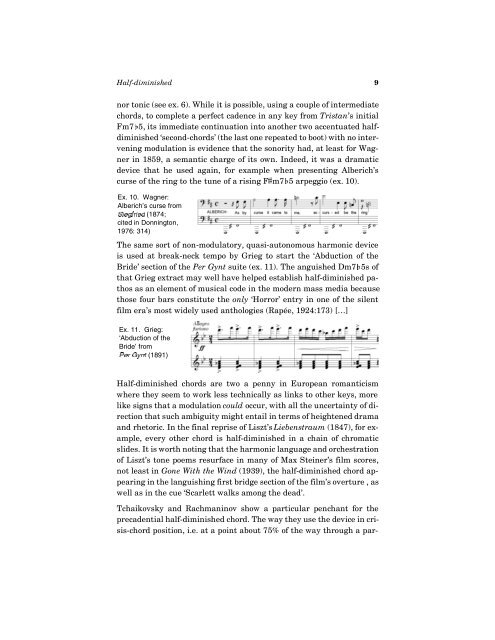Create successful ePaper yourself
Turn your PDF publications into a flip-book with our unique Google optimized e-Paper software.
Half-diminished 9<br />
nor tonic (see ex. 6). While it is possible, using a couple of intermediate<br />
chords, to complete a perfect cadence in any key from Tristan’s initial<br />
Fm7$5, its immediate continuation into another two accentuated halfdiminished<br />
‘second-chords’ (the last one repeated to boot) with no intervening<br />
modulation is evidence that the sonority had, at least for Wagner<br />
in 1859, a semantic charge of its own. Indeed, it was a dramatic<br />
device that he used again, for example when presenting Alberich’s<br />
curse of the ring to the tune of a rising F#m7$5 arpeggio (ex. 10).<br />
Ex. 10. Wagner:<br />
Alberich’s curse from<br />
Siegfried (1874;<br />
cited in Donnington,<br />
1976: 314)<br />
The same sort of non-modulatory, quasi-autonomous harmonic device<br />
is used at break-neck tempo by Grieg to start the ‘Abduction of the<br />
Bride’ section of the Per Gynt suite (ex. 11). The anguished Dm7$5s of<br />
that Grieg extract may well have helped establish half-diminished pathos<br />
as an element of musical code in the modern mass media because<br />
those four bars constitute the only ‘Horror’ entry in one of the silent<br />
film era’s most widely used anthologies (Rapée, 1924:173) […]<br />
Ex. 11. Grieg:<br />
‘Abduction of the<br />
Bride’ from<br />
Per Gynt (1891)<br />
Half-diminished chords are two a penny in European romanticism<br />
where they seem to work less technically as links to other keys, more<br />
like signs that a modulation could occur, with all the uncertainty of direction<br />
that such ambiguity might entail in terms of heightened drama<br />
and rhetoric. In the final reprise of Liszt’s Liebenstraum (1847), for example,<br />
every other chord is half-diminished in a chain of chromatic<br />
slides. It is worth noting that the harmonic language and orchestration<br />
of Liszt’s tone poems resurface in many of Max Steiner’s film scores,<br />
not least in Gone With the Wind (1939), the half-diminished chord appearing<br />
in the languishing first bridge section of the film’s overture , as<br />
well as in the cue ‘Scarlett walks among the dead’.<br />
Tchaikovsky and Rachmaninov show a particular penchant for the<br />
precadential half-diminished chord. The way they use the device in crisis-chord<br />
position, i.e. at a point about 75% of the way through a par-














